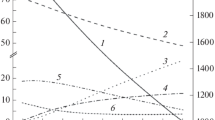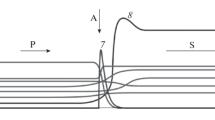Abstract
A comprehensive analysis of synthesis gas (syngas) oxidation kinetics in wide ranges of temperature, pressure, fuel-to-air equivalence ratio, and fuel composition is performed on the basis of the reaction mechanism of syngas ignition and combustion in air. A vast set of experimental data on the ignition delay time, laminar flame propagation velocity, and time evolution of mole fractions of the basic species, which were obtained in shock tubes and in a flow reactor, is used for verification of the kinetic model. Based on a sensitivity analysis, it is shown that the role of reactions determining the basic characteristics of ignition and combustion depends on the composition of the fuel-air mixture and the syngas proper.
Similar content being viewed by others
References
D. J. Wilhelm, D. R. Simbeck, A. D. Karp, and R. L. Dickenson, “Syngas production for gas-to-liquids applications: technologies, issues and outlook,” Fuel Process. Technol., 71, 139–148 (2001).
M. A. Mueller, T. J. Kim, R. A. Yetter, and F. L. Dryer, “Flow reactor studies and kinetic modeling of the H2/O2 reaction,” Int. J. Chem. Kinet., 31, No. 10, 113–125 (1999).
J. Li, Z. Zhao, A. Kazakov, and F. L. Dryer, “An updated comprehensive kinetic model of hydrogen combustion,” Int. J. Chem. Kinet., 36, 566–575 (2004).
M. O’Conaire, H. J. Curran, J. M. Simmie, et al., “A comprehensive modeling study of hydrogen oxidation,” ibid. Int. J. Chem. Kinet., pp. 603–622.
A. A. Konnov, “Remaining uncertainties in the kinetic mechanism of hydrogen combustion,” Combust. Flame, 152, 507–528 (2008).
A. M. Starik, N. S. Titova, L. V. Bezgin, and V. I. Kopchenov, “The promotion of ignition in a supersonic H2-air mixing layer by laser-induced excitation of O2 molecules: Numerical study,” Combust. Flame, 156, No. 8, 1641–1652 (2009).
R. A. Yetter, F. L. Dryer, and H. Rabitz, “A comprehensive reaction mechanism for carbon monoxide/ hydrogen/oxygen kinetics,” Combust. Sci. Technol., 79, 97–128 (1991).
P. Saxena and F. A. Williams, “Testing a small detailed chemical-kinetic mechanism for the combustion of hydrogen and carbon monoxide,” Combust. Flame, 145, 316–323 (2006).
M. Chaos and F. L. Dryer, “Syngas combustion kinetics and applications,” Combust. Sci. Technol., 180, 1053–1096 (2008).
G. A. Pang, D. F. Davidson, and R. K. Hanson, “Experimental study and modeling of shock tube ignition delay times for hydrogen-oxygen-argon mixtures at low temperatures,” Proc. Combust. Inst., 32, 181–188 (2009).
G. Mittal, C. J. Sung, M. Fairweather, et al., “Significance of the HO2 + CO reaction during the combustion of CO + H2 mixtures at high pressures,” Proc. Combust. Inst., 31, 419–427 (2007).
S. M.Walton, X. He, B. T. Zigler, and M. S.Wooldridge, “An experimental investigation of the ignition properties of hydrogen and carbon monoxide mixtures for syngas turbine applications,” Proc. Combust. Inst., 31, 3147–3154 (2007).
F. L. Dryer and M. Chaos, “Ignition of syngas/air and hydrogen/air mixtures at low temperatures and high pressures: Experimental data interpretation and kinetic modeling implications,” Combust. Flame, 152, 293–299 (2007).
D. Bradley, M. Lawes, K. Liu, et al., “Laminar burning velocities of lean hydrogen-air mixtures at pressures up to 1.0 MPa,” Combust. Flame, 149, 162–172 (2007).
E. L. Petersen, D. M. Kalitan, A. B. Barrett, et al., “New syngas/air ignition data at lower temperature and elevated pressure and comparison to current kinetics models,” ibid. Combust. Flame, pp. 244–247.
H. Sun, S. I. Yang, G. Jomaas, and C. K. Law, “Highpressure laminar flame speeds and kinetic modeling of carbon monoxide/hydrogen combustion,” Proc. Combust. Inst., 31, 439–446 (2007).
S. G. Davis, A. V. Joshi, H. Wang, and F. Egolfopoulos, “An optimized kinetic model of H2/CO combustion,” Proc. Combust. Inst., 30, 1283–1292 (2005).
J. Li, Z. Zhao, A. Kazakov, et al., “A comprehensive kinetic mechanism for CO, CH2O, and CH3OH combustion,” Int. J. Chem. Kinet., 39, 109–136 (2007).
A. M. Starik, B. I. Lukhovitskii, and N. S. Titova, “Mechanisms of the initiation of combustion in CH4(C2H2)/air/O3 mixtures by laser excitation of the O3 molecules,” Kinet. Katal., 48, No. 3, 348–366 (2007).
J. V. Michael, J. W. Sutherland, L. B. Harding, and A. F. Wagner, “Initiation in H2/O2: Rate constants for H2 + O2 ? H + HO2 at high temperature,” Proc. Combust. Inst., 28, 1471–1478 (2000).
A. N. Pirraglia, J. V. Michael, J. W. Sutherland, and R. B. Klemm, “Rate coefficient of the O+H2 = OH+H reaction determined via shock tube-laser absorption spectroscopy,” J. Phys. Chem., 93, 282 (1989).
D. L. Baulch, C. T. Bowman, C. J. Cobos, et al., “Evaluated kinetic data for combustion modeling,” J. Phys. Chem. Ref. Data, 34, No. 3, 757–1397 (2005).
X. You, H. Wang, E. Goos, et al., “Reaction kinetics of CO + HO2 ? products: ab initio transition state theory study with master equation modeling,” J. Phys. Chem. A, 111, 4031–4042 (2007).
L. V. Gurvich, I. V. Veyts, and C. B. Alcock, Thermodynamic Properties of Individual Substances, Hemisphere Publ. Co., New York (1989).
A. Burcat and B. Ruscic, “Third millennium ideal gas and condensed phase thermochemical database for combustion with updates from active thermochemical tables,” ANL-05/20 and TAE 960 Technion-IIT, Aerospace Engineering, and Argonne National Laboratory, Chemistry Division (2005).
J. T. Herbon, R. K. Hanson, D. M. Golden, and C. T. Bowman, “A shock tube study of the enthalpy of formation of OH,” Proc. Combust. Inst., 29, 1201–1208 (2002).
R. A. Yetter, F. L. Dryer, and H. Rabitz, “Flow reactor studies of carbon monoxide/hydrogen/oxygen kinetics,” Combust. Sci. Technol., 79, 129–140 (1991).
R. K. Lyon, J. E. Hardy, and W. V. Holt, “Oxidation kinetics of wet CO in trace concentrations,” Combust. Flame, 61, 79–86 (1985).
R. R. Craig, “A shock tube study of the ignition delay of hydrogen-air mixtures near the second explosion limit,” Report No. AFAPL-TR-66-74 (1966).
A. D. Snyder, J. Robertson, D. L. Zanders, and G. B. Skinner, “Shock tube studies of fuel-air ignition characteristics,” Report No. AFAPL-TR-65-93 (1965).
M. Slack and A. Grillo, “Investigation of hydrogen-air ignition sensitized by nitric oxide and nitrogen dioxide,” NASA Report No. CR-2896 (1977).
E. Schultz and J. Shepherd, “Validation of Detailed Reaction mechanisms for detonation simulation,” Tech. Report No. FM 99-5: 230, Cal. Inst. of Tech. Graduate Aeronautical Lab. (2000).
K. A. Bhaskaran, M. C. Gupta, and Th. Just, “Shock tube study of the effect of unsymmetric dimethyl hydrazine on the ignition characteristics of hydrogen-air mixtures,” Combust. Flame, 21, 45–48 (1973).
M. W. Slack, “Rate coefficient for H + O2 +M=HO2 + M evaluated from shock tube measurements of induction times,” Combust. Flame, 28, 241–249 (1977).
A. M. Dean, D. C. Steiner, and E. E. Wang, “A shock tube study of the H2/O2/CO/Ar and H2/N2O/CO/Ar systems,” Combust. Flame, 32, 73–83 (1978).
W. C. Gardiner, M. McFarland, K. Morinaga, et al., “Ignition delays in H2-O2-CO-Ar mixtures,” J. Phys. Chem., 75, 1504–1509 (1971).
E. L. Petersen, D. F. Davidson, M. Röhrig, and R. K. Hanson, /ldHigh-pressure shock-tube measurements of ignition times in stoichiometric H2-O2-Ar mixtures,” in: Proc. of the 20th Int. Symp. on Shock Waves, Pasadena (1995), pp. 941–946.
W. T. Peschke and L. J. Spadaccini, “Determination of autoignition and flame speed characteristics of coal gases having medium heating values,” Electric Power Research Inst., Report EPRI AP-4291 (1985).
M. Filatov, W. Reckien, S. D. Peyerimhoff, and S. Shaik, “What are the reasons for the kinetic stability of a mixture of H2 and O2?” J. Phys. Chem., 104, 12014–12020 (2000).
S. H. Mousavipour and V. Saheb, “Theoretical study on the kinetic mechanism of H + HO2 reaction,” Bull. Chem. Soc. Jpn., 80, No. 10, 1901–1913 (2007).
S. D. Tse, D. L. Zhu, and C. K. Law, “Morphology and burning rates of expanding spherical flames in H2/O2/inert mixtures up to 60 atmospheres,” Proc. Combust. Inst., 28, 1793–1800 (2000).
K. T. Aung, M. I. Hassan, and G. M. Faeth, “Flame stretch interactions of laminar premixed hydrogen/air flames at normal temperature and pressure,” Combust. Flame, 109, 1–24 (1997).
C. K. Law, “A compilation of experimental data on laminar burning velocities,” in: N. Peters and B. Rogg (eds.), Reduced Kinetic Mechanisms for Applications in Combustion Systems, Springer-Verlag, Berlin (1993), pp. 15–26.
T. Iijima and T. Takeno, “Effects of temperature and pressure on burning velocity,” Combust. Flame, 65, 35–43 (1986).
F. Takahashi, M. Mizomoto, and S. Ikai, “Numerical studies on the structure of two-dimensional H2/air premixed jet flame,” Alternative Energy Sources III, 5, 447–457 (1983).
C. K. Wu and C. K. Law, “On the determination of laminar flame speeds from stretched flames,” in: Proc. Combust. Inst., 20, 1941–1949 (1984).
D. R. Dowdy, D. B. Smith, S. C. Taylor, and A. Williams, “The use of expanding spherical flames to determine burning velocities and stretch effects in hydrogen/air mixtures,” in: Proc. Combust. Inst., 23, 325–332 (1991).
J. Natarajan, T. Lieuwen, and J. Seitzman, “Laminar flame speeds of H2/CO mixtures: effect of CO2 dilution, preheat temperature, and pressure,” Combust. Flame, 151, 104–119 (2007).
M. I. Hassan, K. T. Aung, and G. M. Faeth, “Properties of laminar premixed CO/H2/Air flames at various pressures,” J. Propulsion Power, 13, No. 2, 239–245 (1997).
I. C. McLean, D. B. Smith, and S. C. Taylor, “The use of carbon monoxide/hydrogen burning velocities to examine the rate of the CO + OH reaction,” in: Proc. Combust. Inst., 25, 749–757 (1994).
R. J. Kee, F. M. Rupley, J. A. Miller, et al., CHEMKIN Collection, Release 3.6, Reaction Design, Inc., San Diego, CA (2000).
Author information
Authors and Affiliations
Corresponding author
Additional information
Translated from Fizika Goreniya i Vzryva, Vol. 46, No. 5, pp. 3–19, September–October, 2010
Rights and permissions
About this article
Cite this article
Starik, A.M., Titova, N.S., Sharipov, A.S. et al. Syngas Oxidation Mechanism. Combust Explos Shock Waves 46, 491–506 (2010). https://doi.org/10.1007/s10573-010-0065-x
Received:
Published:
Issue Date:
DOI: https://doi.org/10.1007/s10573-010-0065-x




